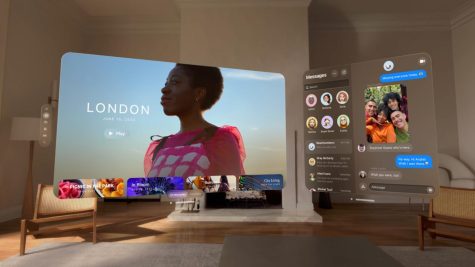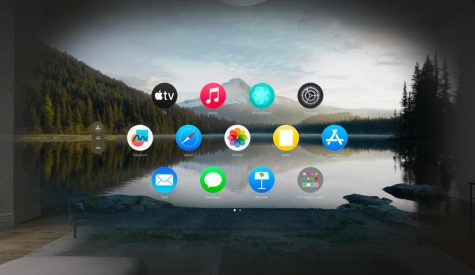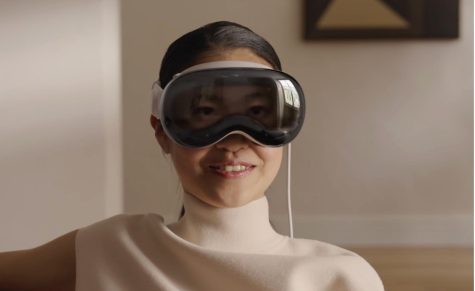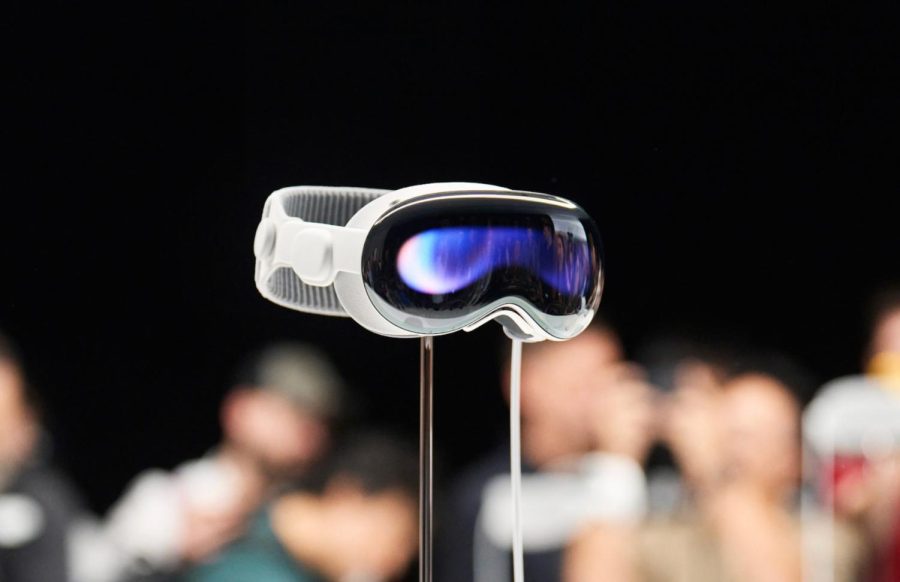How much money are you willing to spend on heaven? How much dough are you willing to whip out to ascend to a higher plane; a plane where anything and everything seems limitless and bountiful? Apple is setting it at a steep $3,499— no that is not a typo. Thirty five hundred dollars.
Apple’s Vision Pro is a mixed reality headset that can transform the way you interact with your world. Unlike other headsets, Vision Pro is the first device that you look through rather than look at. Vision Pro doesn’t obscure your surroundings, instead, it uses six cameras and 23 million pixels to display your space around you, making it feel like there’s no headset at all, seamlessly blending all digital content with your physical space.

Vision Pro is ‘magically’ controlled with just your eyes, hands, and voice. Rather than using a controller to select and click to interact, Vision Pro uses sensors to track your eye and hand movements, just pinch to select, flick to scroll and issue voice commands to interact with your new $3499 digital world.
Vision Pro’s interface is beautifully designed to integrate into your space, app windows cast faux shadows and when watching a movie, Vision Pro casts a light glow in your surroundings much like a screen does. Its interface is beautifully designed to prioritize creativity and productivity which you will be needing to do a lot of, if you’re going to financially recover from your thirty-five hundred dollar purchase.
This is all completely revolutionary, anything that has come close to it in the past few years has arguably been from Oculus, another company that makes headsets. But Oculus’ headsets are mostly aimed at VR Gamers, to create an immersive gaming experience, which is not really Vision Pro’s aim. And none of Oculus’ headsets are meant to fully support passthrough video or have advanced eye and hand tracking, unlike Vision Pro.
Apple aims to be different from Oculus by making Vision Pro a utility, rather than a toy or a VR gaming machine. Being able to seamlessly project your Macbook screen into an infinitely larger ‘screen’, it can become every display you’ve ever wanted and with its fancy spatial audio, it can also be every speaker you’ve ever wanted. And with Landscapes you can completely transform your space into, sand dunes, or a beautiful natural landscape.

All of these things make the Vision Pro literally in a league of its own; its powerful Apple Silicon chips, its best-in-class hand and eye tracking, and its 4K displays make Vision Pro unlike anything we’ve ever seen. But spending $3499 on what they call ‘the most advanced personal electronics device ever’ is still a really hard sell. Especially when Apple has made some… quirky decisions with Vision Pro.
So, since Vision Pro has six outward facing cameras, it’s Apple’s first 3D camera. You can create beautiful and realistic spatial photos and videos, just strap on your huge goggles and tap the button above the headset. This is extremely natural and not eerie at all.

This certainly does not help Vision Pro’s black mirror-esque feeling. This idea that you would have Vision Pro on often enough to capture natural and intimate moments is clearly not what people are looking for.
I’m of course exaggerating a bit here— Apple doesn’t aim to keep you strapped into Vision Pro all the time (and its abysmal two hour battery life is partially to blame here). One of the ways Apple prevents isolation when using Vision Pro is with EyeSight. Okay, bare with me on this one. On the front of Vision Pro is a screen that displays your eyes. It DISPLAYS YOUR EYES.

And it is exactly as uncanny as it sounds. The eyes that Vision Pro shows are uhhhh… a little scary. Using the same sensors that track your eye movement, Vision Pro creates a simulacrum of your eyes, even showing where your eyes move on the headset.
The reason Apple created EyeSight is clearly to better communicate it as a Mixed Reality Headset. With Vision Pro on, you can still fully see, so to communicate that with the people around you, it displays your eyes, and when using Vision Pro in Full Screen, it shows an animation on the front to tell people who are now $3,499 richer than you that you’re a little busy.
But there’s one more question to ask here, Why would we create this? Vision Pro fixes problems that just weren’t there in the first place and the problems that it creates are clearly not worth its enormous price tag. This idea that wearing a heavy metal and glass enclosure around your eyes brings you closer to some productivity heaven feels innately dystopian. In their words, “If you purchased a new state-of-the-art TV, surround sound system, powerful computer with multiple high-definition displays, high-end camera, and more, you still would not have come close to what Vision Pro delivers.” But what they forget to mention is that most people don’t desire to have all of those things. Most people don’t need a ‘state-of-the-art TV’ or a ‘high-end camera’ and they definitely don’t need it all on their face.
There’s no doubt in my mind that Apple will live up to these expectations. That Vision Pro will be as jaw-dropping and revolutionary as all sounds (And with people’s initial thoughts, it looks like it is.) Apple has a trend of setting the bar high for tech as other companies rush to meet it. The Apple Watch, AirPods, and to some extent, the iPhone are all examples of Apple’s huge influence on the tech industry.
Apple announced the Vision Pro at WWDC, a world wide conference for developers. It’s clear that Vision Pro is more of a proof of concept if anything. Much like the first Apple Watch, Vision Pro is mostly inaccessible to anybody who’s not a millionaire or a developer. But also like the first Apple Watch, it’s going to be up to developers to really flesh out what Reality Pro and its future iterations will really look like.
Until then, I’ll keep my non $3,499 iPhone and my non $3,499 Macbook. And when Apple eventually releases a cheaper successor of Vision Pro, we’ll see if heaven will be worth it then.
Vision Pro comes out early 2024, at an affordable price of $3,499.





































